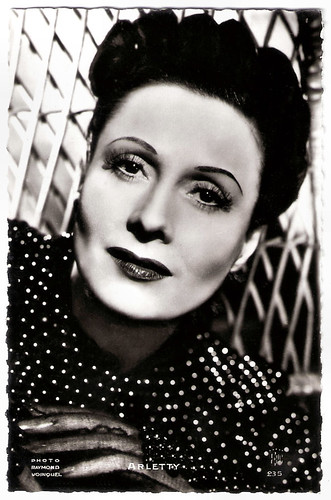
French postcard by EPC, no. 235. Photo: Raymond Voinquel.
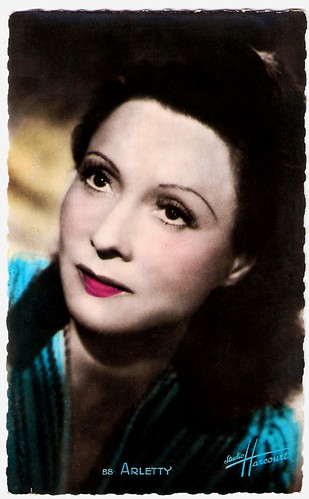
French postcard by S.E.R.P., Paris, no. 88. Photo: Studio Harcourt.
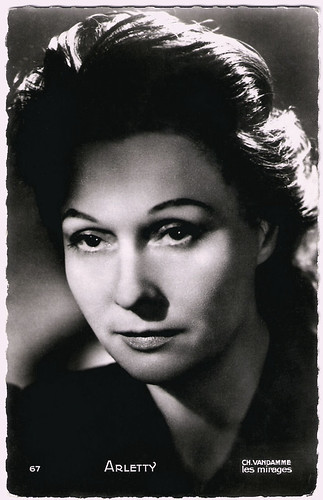
French postcard by Editions P.I., no. 67. Offered by S.A. Victoria, Brussels, no. 639. Photo: Ch. van Damme / Les Mirages.
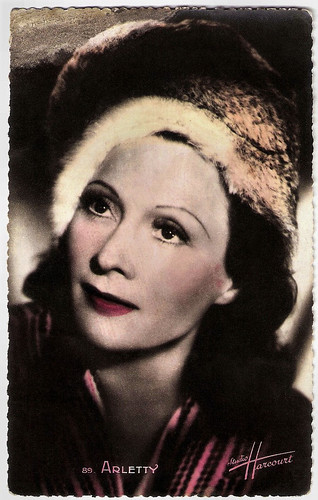
French postcard by SERP, Paris, no. 89. Photo: Studio Harcourt.
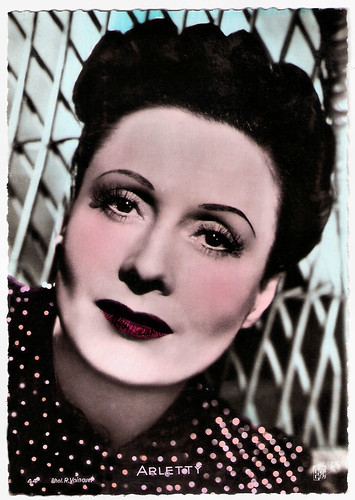
French postcard by Editions et Publications Cinematographiques (EPC), no. 44. Photo: Raymond Voinquel.
A seductive siren
Arletty was born Léonie Marie Julie Bathiat in Courbevoie near Paris in 1898, to a working-class family. Her father was a streetcar driver, and her mother a linen maid. In 1914 on the third day of the First World War, she lost her lover, a boy whose eyes were so blue that everybody called him "Ciel" (Sky). She then swore she would never marry nor have children, so she could never become a war widow or the mother of a dead soldier. She would hold word despite affairs with Sacha Guitry and Aga Khan.
Arletty worked for a time in a factory and as a secretary before becoming a model for painters and photographers. In 1918 she started her stage career as a chorus girl in the music hall. In 1920 she joined the Théâtre des Capucines and appeared there in innumerable revues. At other Parisian theatres, she also appeared in such operettas as 'Oui' (Yes, 1928) and comedies such as 'Les Joies du Capitole' (The Enjoyments of the Capitol, 1936) and 'Fric-Frac' (Burglars, 1936).
Arletty was already a stage performer for ten years before she made her film début in La douceur d'aimer/The Sweetness of Loving (René Hervil, 1930). The arrival of sound cinema coincided with Arletty’s move into films. In the following years, she appeared in such comedies as Enlevez-moi (Léonce Perret, 1932) with Roger Tréville, Mademoiselle Josette, ma femme/Miss Josette, My Wife (André Berthomieu, 1933) starring Annabella, and Amants et voleurs/Lovers and Thieves (Raymond Bernard, 1935) opposite Michel Simon.
These early film appearances established her as the strong yet marginalised female character with which she would be most identified in later years. In 1935, Arletty was directed by Jacques Feyder in the film Pension Mimosas. She dazzled film audiences in Marcel Carné and Jacques Prevert's classics of French poetic realism, Hôtel du Nord/Hotel of the North (Marcel Carné, 1938) starring Annabella, Le Jour se lève/Daybreak (Marcel Carné, 1939) with Jean Gabin, and Les Visiteurs du soir/The Devil's Envoys (Marcel Carné, 1942) with Alain Cuny.
She played a marvellous leading lady full of cheeky humour and charm again opposite Michel Simon in the film comedies Fric-frac/Burglars (Claude Autant-Lara, Maurice Lehmann, 1939) and Circonstances atténuantes/Extenuating Circumstances (Jean Boyer, 1939). Arletty rarely received top billing although she outshone the lead actors in most of her films. The anonymous biographer at French Films writes: “In her films, Arletty was rarely the heroine, the kind of character to win the audience’s sympathy. Rather, she was usually the seductive siren, who would win a man’s heart and then abandon him. Arletty was arguably the first and the best, of the film femme fatales, a perfect subject for the poetic realists of the late 1930s.”
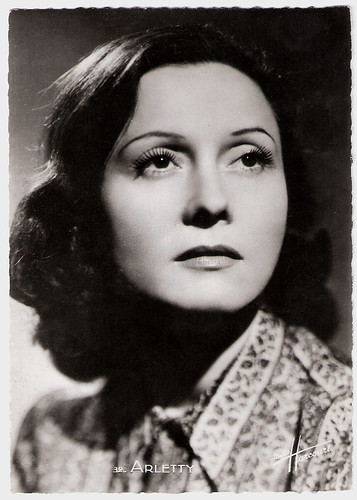
French postcard by Greff Editeur, Paris, no. 32. Photo: Studio Harcourt.
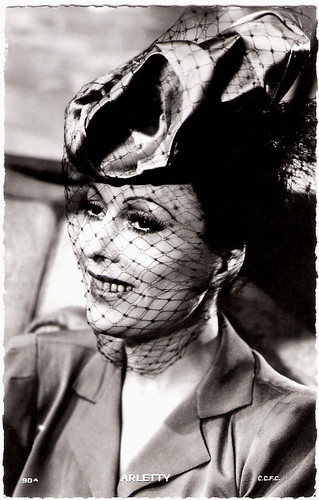
French postcard by Edit. Chantal, Rueil, no. 90A. Photo: C.C.F.C.
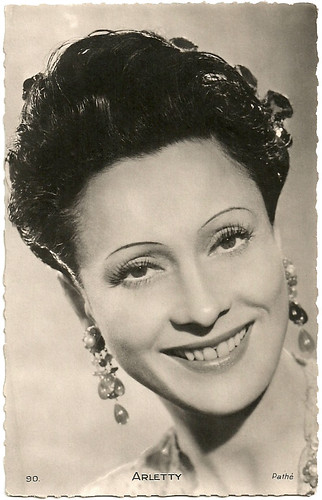
French postcard by Editions E.C., Paris, no. 90. Photo: Pathé.
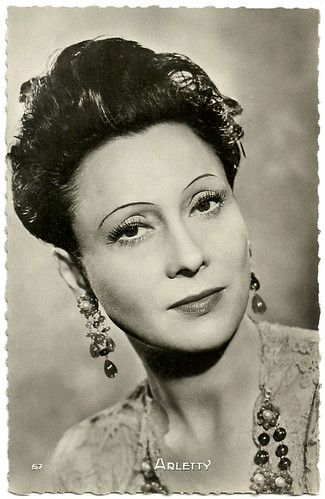
French postcard by Editions P.I., Paris, no. 67.
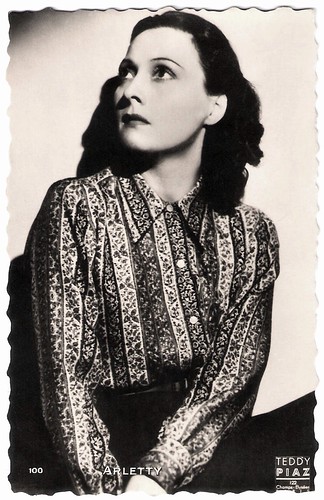
French postcard by Editions O.P., Paris, no. 100. Photo: Teddy Piaz.

French postcard by Edit. Chantal, Rueil, no. 90. Photo: Roger Richebé. Publicity still for Madame Sans-Gêne (Roger Richebé, 1941).
Horizontal collaboration
Arletty’s fourth and best role for Marcel Carné, the central part of Garance in Les Enfants du Paradis/Children of Paradise (Marcel Carné, 1945) would become her most famous film role. Hal Erickson at AllMovie: “Even in 1945, Marcel Carné's Children of Paradise was regarded as an old-fashioned film. Set in the Parisian theatrical world of the 1840s, Jacques Prévert's screenplay concerns four men in love with the mysterious Garance (Arletty). Each loves Garance in his own fashion, but only the intentions of sensitive mime-actor Deburau (Jean-Louis Barrault) are entirely honourable; as a result, it is he who suffers most, hurdling one obstacle after another in pursuit of an evidently unattainable goal.
In the stylised fashion of 19th-century French drama, many grand passions are spent during the film's totally absorbing 195 minutes. Amazingly, the film was produced over a two-year period in virtual secrecy, without the knowledge of the Nazis then occupying France, who would surely have arrested several of the cast and production staff members (including Prévert) for their activities in the Resistance. Children of Paradise has gone on to become one of the great romantic classics of international cinema.” Marlene Pilaete comments: "The filming of Les enfants du Paradis was no secret for anyone. It was a big production, loaded with stars, with thousands of extras. The movie was announced and advertised in the press at the time and the filming took place in full sight of everyone. (...) Although he has never been a collaborationist and he was certainly not a Nazi sympathizer, Prévert has worked openly in France during the war (Les visiteurs du soir, Une femme dans la nuit, Lumière d’été, Adieu Léonard, etc.). If Nazis had really wanted to arrest him, they could have done it easily."
After the Liberation, Arletty’s career suffered a severe drawback owing to a liaison with a German Officer during the Occupation. For liberated France, she became the symbol of treason or what was called ‘horizontal collaboration’, and for that, she had to pay. The price proved to be very high. She was arrested and sent to Drancy concentration camp then to Fresnes prison (near Paris) where she spent 120 days. In December 1944, she was put under house arrest for another two years and condemned to three years work suspension. She was not invited to the premiere of Les Enfants du Paradis in March 1945. She allegedly later commented on the experience, "My heart is French but my ass is international." After the suspension, she appeared in Carné’s La fleur de l'âge/The Flower of Youth (Marcel Carné, 1947) starring the young Anouk Aimée. In pre-war France, children were jailed under horrific conditions. The film tells of the massive escape that took place on the island of Belle-Ile-en-Mer, and of the child hunt that ensued. The shooting of the film started several times, and was halted for censorship reasons - the project was banned by the Ministry of Justice - and harsh shooting conditions, and finally abandoned. All material of La fleur de l'âge was inexplicably lost in the 1950s.
Arletty next appeared in such films as Portrait d'un assassin/Portrait of a Murderer (Bernard-Roland, 1949) with Maria Montez and Erich von Stroheim, Huis clos/No Exit (Jacqueline Audry, 1954) based on the play by Jean-Paul Sartre, and L'air de Paris (Marcel Carné, 1954) opposite Jean Gabin. However, the cinema did not offer her the grand roles of the pre-war years any more. She returned to the theatre and enjoyed a moderately successful period as a stage actor in later life, notably as Blanche in 'A Streetcar Named Desire'. Among her final screen appearances were a fleeting cameo as an elderly French woman in the international war epic The Longest Day (Ken Annakin, Andrew Marton, Bernhard Wicki, 1962) and a small part in the comedy-drama Le voyage à Biarritz/The Trip to Biarritz (Gilles Grangier, 1963) starring Fernandel.
In 1963, an accident left her nearly blind and forced her to retire. She eventually returned to the stage, notably in the leading role in Jean Cocteau’s Les Monstres sacrés (The Holy Monsters, 1966), and to film as a madam in Jean-Claude Brialy’s Les Volets fermés/The Closed Shutters (Jean-Claude Brialy, 1972). In 1971 she published an autobiography, La Défense. Arletty died in 1992. The funeral cortege made a stop in front of the Hotel du Nord in Paris where her famous film of 1938 is located. Christopher Gresecque at IMDb: “She always illuminated the screen with an unusual mixture of Parisian working-class sense of humor and her romantic beauty.”

French postcard by Editions du Centre Pompidou and Flammarion, 1994 / Affiches Gaillard, Paris. Design by Jacques Bonnaud. Reproduction of the original poster for the film Les enfants du paradis. I. Le boulevard du crime (Marcel Carné, 1943-1945).
75th Anniversary Trailer for Le Jour se lève/Daybreak (1939). Source: Studiocanal UK (YouTube).
U.S. Re-Release Trailer for Les Enfants du Paradis/Children of Paradise (1945). Source: Janus Films (YouTube).
French trailer for the TV film Arletty, une passion coupable/Arletty, a guilty passion (Arnaud Sélignac, 2015) with Laetitia Casta as Arletty. Source: Flach Film Production (YouTube).
Sources: Marlene Pilaete, Hal Erickson (AllMovie), Christophe Greseque (IMDb), French Films, Encyclopaedia Brittanica, AlloCiné (French), Wikipedia and IMDb.
This post was last updated on 22 April 2022.
No comments:
Post a Comment